Chiefland Astronomy Heritage Museum
Showcasing telescope and other unique astronomy related items since its founding in October 2024.



Official Dedication on March 29, 2025
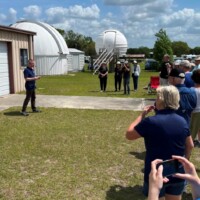
Dedication
Dedication of the Chiefland Astronomy Heritage Museum on March 29, 2025.
Did you know that some of the most important astronomical discoveries in history were made by amateurs?
William Herschel discovered Uranus from his garden using a telescope he built himself.
Maria Mitchell spotted a comet from a small rooftop observatory and became the first female professional astronomer in the United States.
Every telescope in this museum has a story. Behind each one, many hands played a part. Someone imagined the design, someone ground the glass for the lens or mirror, someone built the mount, someone brought it to market, and finally, an amateur astronomer chose that instrument and aimed it at the sky. These telescopes aren’t just tools; they’re time machines, conversation pieces, and companions for countless nights under the stars. They remind us that astronomy has always been a deeply personal journey, shared across generations.
And that’s what we’re here to celebrate today.
I am Richard Hennig, the Curator of the Chiefland Astronomy Heritage Museum.
It’s a real pleasure to stand before you today at the dedication of the Chiefland Astronomy Museum. This is a moment many of us have looked forward to, and today, thanks to our shared passion for the night sky and a strong sense of community, it becomes a reality.
I want to begin by thanking everyone who helped make this possible, through your time, your skills, your generosity, and your encouragement.
To those working steadily behind the scenes:
David Froiseth, who took the lead on restoration. Your craftsmanship and attention to detail brought these instruments back to life.
Lisa Eager, who kept everything running smoothly and helped make this space both practical and inviting.
Matthew Peters, who shaped the museum’s communications and helped us tell its story to the wider world.
Sarah Coates, our archivist. Your careful work documenting the collection turned this into more than a display.
And Larry Arbeiter, who has helped connect the museum with the broader public through thoughtful outreach.
Our museum has truly been a team effort. Without so many people stepping up and pitching in, we wouldn’t be here today.
To the donors who shared their telescopes, cameras, mounts, and instruments: Thank you. You’ve preserved a rich part of our astronomical heritage and opened the door for future generations to explore and be inspired by it.
To the Chiefland Astronomy Village and especially the Chiefland Astro members: Your financial support has been essential. But just as important has been your enthusiasm. This museum reflects your belief in the value of preserving and sharing the tools and stories of amateur astronomy.
To the educators who have joined us today: Thank you. We’re newly interested in sharing some of our knowledge, equipment, and enthusiasm with the public. And there are no better allies for that than teachers, whose very profession is devoted to education. We are fortunate to have several Levy County science teachers here with us today. I want to welcome you and encourage you to chat with me later.
Thanks also to Chiefland’s Vice-Mayor, Lewrissa Johns, for supporting our outreach efforts. And to Tammy Boyle, Superintendent of Schools for Levy County, who encouraged the teachers to join us today.
And on a personal note, I want to thank my family for their support and patience throughout this project. I’m grateful for the time and space they gave me to work on it — I couldn’t have done this without them.
This museum isn’t just a collection of old instruments. It’s a record of curiosity — of people who looked up at the stars and wanted to know more. It’s a place to learn, to reflect, and to be inspired. And I hope it continues to grow and evolve as a space that connects the past with the future of skywatching.
That’s why we call this a living museum. While we have exhibits that showcase a remarkable range of historical telescopes and amateur astronomy equipment, we’re also always looking to grow. If you have historical catalogs, manuals, books, telescopes, or other astronomy-related items you’d like to see displayed, let’s talk. We welcome suggestions and contributions from everyone on how to make the museum better.
That spirit of a living museum isn’t just about what’s on display. It’s also about what we do with it. Just inside the entrance, on your right, you’ll see a set of telescopes without labels or plaques. These aren’t part of the historical exhibit; they’re part of our future. These are our outreach telescopes, set aside for use during public events, especially with school groups and visiting guests. On select evenings, we’ll begin by showcasing astronomical objects on our large screen, and then move outside to observe them directly using these very instruments. It’s a hands-on, eyes-on kind of astronomy, and if you’re interested in attending one of these nights or helping out, once again: let’s talk.
I hereby dedicate the Chiefland Astronomy Museum to all amateur astronomers, those who came before us, and those who will one day walk through its exhibits and have their curiosity sparked.
Thank you all for being part of this journey and for being here today to celebrate it. Let’s continue reaching for the stars, together.
Telescope and Mount Collection
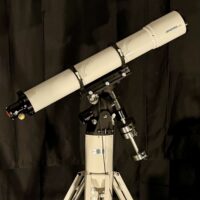
Astro-Physics 155 f/9 EDT
Astro-Physics introduced the 155 EDT f/9 refractor in 1992. This was part of a new line of refractor lenses that incorporated ED glass. Astro-Physics only produced a small number of these longer-focal length oil-spaced triplets before switching to the f/7 version in the second year of EDT’s production. The Astro-Physics 800 mount was introduced in the mid-80s and available until the early 90s. The Astro-Physics 800 mount was eventually replaced by the Astro-Physics 900 series, specifically the 900QMD and later the 900GTO models.
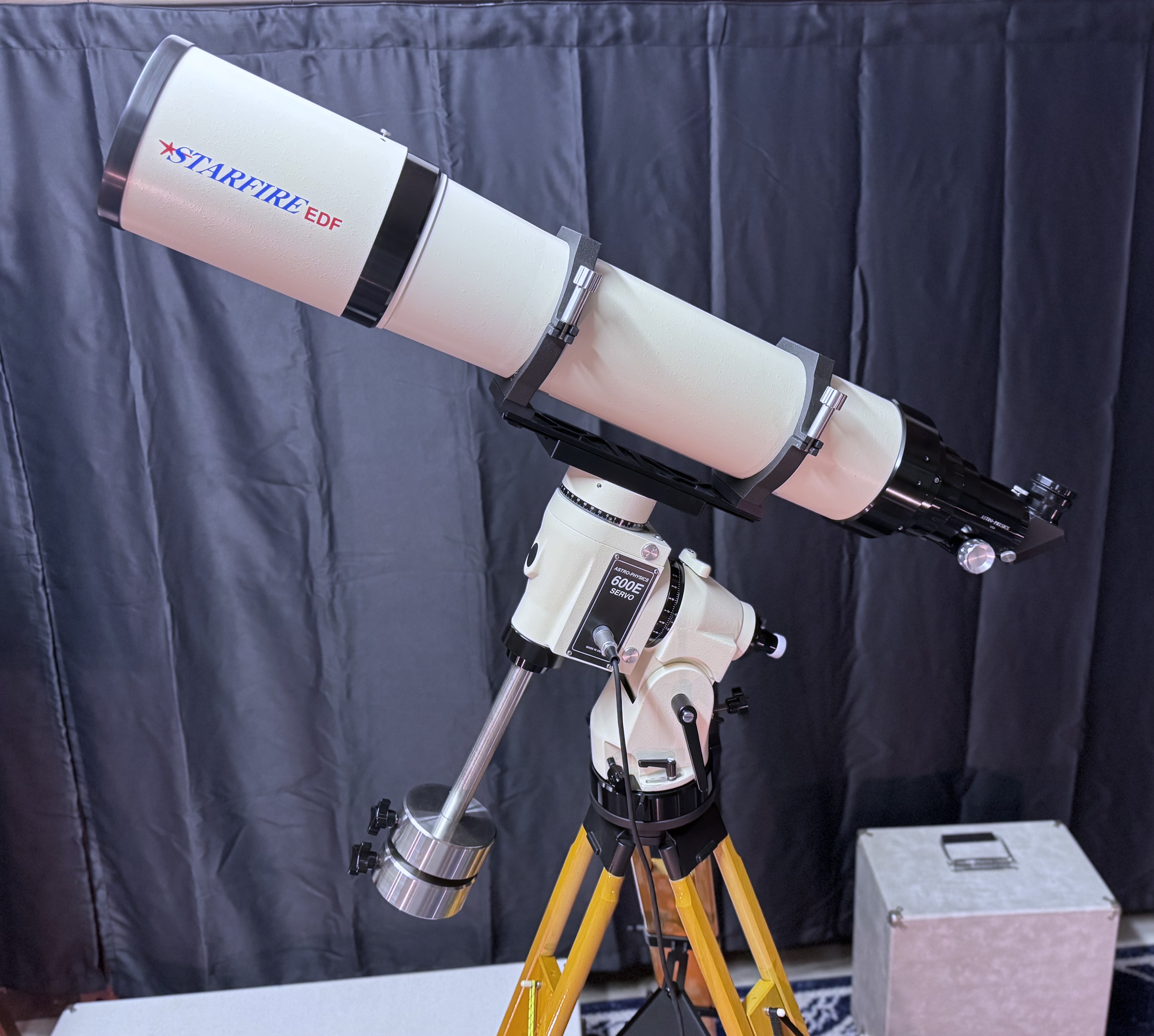
Astro-Physics 155 f/7
Alan Dyer reviewed the 155 EDF Astro-Physics Refractors in the 1993 September issue of Astronomy magazine in an article titled Big & Small. He states: “Optical performance of the 155EDF was impressive. It produced nary a trace of false color even on Venus. Equally impressive, this scope provided superb images as soon as it was set outside. Even in sub-freezing temperatures, image quality, though not perfect at first, was surprisingly sharp from the start. In cold weather, after a modest settle-down time of 30 minutes, in-focus star images were textbook Airy disks with a well-defined first diffraction ring and a trace of a second outer ring. There was no sign of spherical aberration, lens figure changes, heat plumes, or distorted Airy disks due to tube turbulence.”
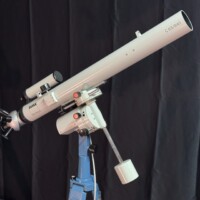
Carl Zeiss Telemator
The Telementor and Telemator refractors are iconic telescopes that exemplify the precision engineering and craftsmanship of Carl Zeiss, a renowned German optics manufacturer. Carl Zeiss Jena, located in East Germany, was responsible for producing these telescopes during the Cold War era. The Telementor series was marketed primarily to schools, universities, and amateur astronomers, reflecting its dual role as an educational and observational instrument. The Telementor made its first appearance in May 1972 and quickly became a favorite among amateur astronomers, educators, and observatories.
The telescope features a 63mm cemented doublet with a focal length of 840mm, giving an f/13.3 ratio. This design has minimal chromatic aberration, making it ideal for lunar, planetary, and double-star observations. The Telementor came on the equatorial T-mount with a robust design that requires manual tracking. The Telemator added an electric clock drive, making the TM mount better suited for education. The Telementor originally came with a helical rear focuser. The later Telementor-II and Telemator have an internal focusing mechanism that moves the objective lens in the refractor tube.
The Telementor’s origins and legacy are tied to the Cold War divide between East and West Germany. Despite the geopolitical barriers, Carl Zeiss Jena telescopes gained a cult following worldwide for their optical quality and reliability. Today, the Telementor and Telemator are highly sought after by collectors and astronomy enthusiasts who appreciate their timeless design, optical quality, and historical significance. They remain a testament to Carl Zeiss’s expertise in crafting world-class optical instruments.
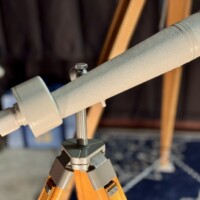
Carl Zeiss Asiola
63mm f/6.7 Achromatic Refractor, Carl Zeiss Jena, East Germany, ca. 1970s. This compact spotting scope features a 63mm aperture and short 420mm focal length, offering sharp, high-contrast views ideal for terrestrial observation. Produced by the renowned Carl Zeiss factory in Jena during the Cold War era, the Asiola combined precision optics with rugged construction. Popular among naturalists and birdwatchers, it represents the high-quality civilian optics made behind the Iron Curtain.
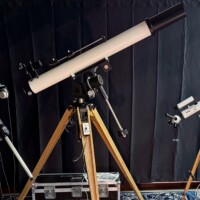
4.5” Dobbins
The Dobbins Instrument Co., a telescope manufacturing company, made more than 100 telescopes. The Dobbins Instrument Company started in November 20, 1979, and lasted until 1991. The Company was started by Thomas J. Dobbins (August 13, 1922 – November 9, 2002) and his son, Thomas A. Dobbins (Born: August 4, 1958). Dobbins Instrument Company was located in Lyndhurst, Ohio, Cuyahoga County. In 1992, the rejuvenated company went by the name A.R.O. Instrument Company, and lasted until 1997. A.R.O. Instrument Company was located in Coshocton, Ohio, Coshocton County.
The Dobbins refractor on display is 4.5” f/12.5 refractor on a Mark III motorized mount. The scope and mount were built in the 1980s.
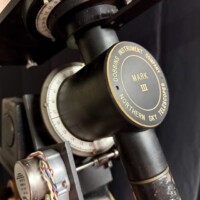
Mark III Mount
The Dobbins Instrument Co., a telescope manufacturing company, made more than 100 telescopes. The Dobbins Instrument Company started in November 20, 1979, and lasted until 1991. The Company was started by Thomas J. Dobbins (August 13, 1922 – November 9, 2002) and his son, Thomas A. Dobbins (Born: August 4, 1958). Dobbins Instrument Company was located in Lyndhurst, Ohio, Cuyahoga County. In 1992, the rejuvenated company went by the name A.R.O. Instrument Company, and lasted until 1997. A.R.O. Instrument Company was located in Coshocton, Ohio, Coshocton County.
The Dobbins refractor on display is 4.5” f/12.5 refractor on a Mark III motorized mount. The scope and mount were built in the 1980s.

Vixen Custom 80M Refractor
The Custom 80M is a classic 80mm f/11 achromatic refractor made by Vixen in Japan during the 1980s, a period known for high-quality amateur telescopes. With a 910mm focal length and precision-crafted optics, it offers sharp, high-contrast views of the Moon, planets, and double stars. This version is paired with a sturdy alt-az mount for nature observations. Renowned for its optical excellence and mechanical reliability, the 80M became a favorite among dedicated visual observers.
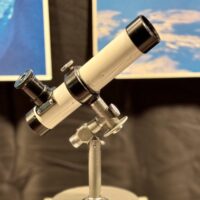
Swift Tecnar 816
This compact 60mm f/6.6 refractor was marketed as a “Satellite Tracker” during the dawn of the Space Age. With its wide field of view and short 400mm focal length, the Tecnar 816 was well-suited for visually following satellites as they moved rapidly across the night sky. Built in Japan by Swift Instruments, it was among the types of instruments used by civilian observers in Project Moonwatch—a Smithsonian Astrophysical Observatory initiative that enlisted volunteers worldwide to track the first artificial satellites, including Sputnik 1. The Tecnar 816 embodies the spirit of Cold War-era citizen science and the global enthusiasm for space exploration.

Dynascope 6” f/8
The Criterion Co. was established at 331 Church Street, Hartford 3, Connecticut, by Mr. John Krewalk, Sr. In time, it became the Criterion Manufacturing Company, Inc. His son John J. Krewalk (b. 1950) would, in time, come to work for the company too.
The first telescope offered by the Criterion Co. was the 1954 model 1.6 inch (40mm) aperture f/25 achromatic refracting telescope. This included three eyepieces providing 40, 80, and 111x magnification. Resembling a walking stick, it was provided on a simple alt-az mount and tripod standing about 5 feet tall and sold for $26.95. A few months after the 1.6-inch telescope became available, Criterion announced the first Dynascope, a four-inch (4″) Newtonian reflecting telescope that sold with three eyepieces in 1954 for $44.95 plus shipping. As telescope mounts and accessories improved, costs escalated accordingly. So by 1956, Criterion (among other telescope makers) was offering payment plans of up to twenty-four months.
By 1955, the first commercial 6-inch f/8 Newtonian telescope became available, made by competitor Edmund Salvage Co. This undoubtedly put pressure on Criterion to respond. Criterion may have already had their answer in the works, for in the December 1956 issue of Sky and Telescope, they announced the new series of Newtonian telescopes. This would initially include the Dynascope 6-inch with either a German mount with a wooden tripod or a deluxe German mount with a massive steel pier, and the line would grow to include models with apertures as large as 16 inches. The deluxe 6-inch Newtonian telescope, with a massive pier mount that resembled the flared bell of a trumpet, cost $475. That is $5,437 in today’s dollars.
The model on display here is the standard 6″ Dynascope from 1959.
Several versions of the Dynascope 6 telescope were produced, but the real value series RV-6, which would come to dominate its class, would not appear until January 1959 when Criterion’s two-page spread in Sky and Telescope revealed it.
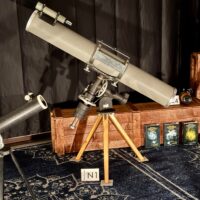
Dynascope 6” f/8
The Criterion Co. was established at 331 Church Street, Hartford 3, Connecticut, by Mr. John Krewalk, Sr. In time, it became the Criterion Manufacturing Company, Inc. His son John J. Krewalk (b. 1950) would, in time, come to work for the company too.
The first telescope offered by the Criterion Co. was the 1954 model 1.6 inch (40mm) aperture f/25 achromatic refracting telescope. This included three eyepieces providing 40, 80, and 111x magnification. Resembling a walking stick, it was provided on a simple alt-az mount and tripod standing about 5 feet tall and sold for $26.95. A few months after the 1.6-inch telescope became available, Criterion announced the first Dynascope, a four-inch (4″) Newtonian reflecting telescope that sold with three eyepieces in 1954 for $44.95 plus shipping. As telescope mounts and accessories improved, costs escalated accordingly. So by 1956, Criterion (among other telescope makers) was offering payment plans of up to twenty-four months.
By 1955, the first commercial 6-inch f/8 Newtonian telescope became available, made by competitor Edmund Salvage Co. This undoubtedly put pressure on Criterion to respond. Criterion may have already had their answer in the works, for in the December 1956 issue of Sky and Telescope, they announced the new series of Newtonian telescopes. This would initially include the Dynascope 6-inch with either a German mount with a wooden tripod or a deluxe German mount with a massive steel pier, and the line would grow to include models with apertures as large as 16 inches. The deluxe 6-inch Newtonian telescope, with a massive pier mount that resembled the flared bell of a trumpet, cost $475. That is $5,437 in today’s dollars.
The model on display here is the standard 6″ Dynascope from 1959.
Several versions of the Dynascope 6 telescope were produced, but the real value series RV-6, which would come to dominate its class, would not appear until January 1959 when Criterion’s two-page spread in Sky and Telescope revealed it.
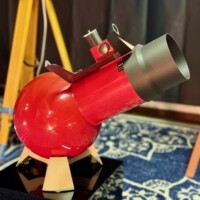
Astroscan 2001
When Edmund Scientific introduced the telescope in 1976, they called it The Edmund Wide-Field Telescope with a Part Number 2001. Edmund had a public contest, which ran until November 15, 1976, to come up with a name. The winning name was Astroscan 2001.
The Astroscan continued to be available after Edmund Scientific was acquired by Science Kit and Boreal Laboratories in 2001, with the telescope for sale on the Edmund Scientific website. Production and sales of the telescope ceased in 2013 when the mold for the plastic body broke.
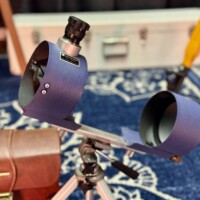
Coulter CT-100
The World’s Most Compact and Versatile 4 ¼” Telescope System.
While Coulter’s advertisement slogan may be stretching it a bit, this tiny scope is certainly unique.
Early versions of the travel scope made in 1978 had a short focal ratio of f/3.5, which was changed to f/4 in 1979. Coulter even showed an f/8 version in their advertisements, though it’s not clear that the f/8’s were ever actually sold.
The one in our museum is an early f/3.5 models and from the first batch made. It did not even include the manual but a note from the factory that a manual would be shipped once they had it finished.
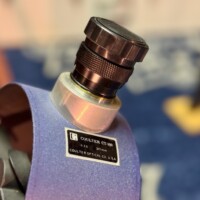
Coulter CT-100
The World’s Most Compact and Versatile 4 ¼” Telescope System.
While Coulter’s advertisement slogan may be stretching it a bit, this tiny scope is certainly unique.
Early versions of the travel scope made in 1978 had a short focal ratio of f/3.5, which was changed to f/4 in 1979. Coulter even showed an f/8 version in their advertisements, though it’s not clear that the f/8’s were ever actually sold.
The one in our museum is an early f/3.5 models and from the first batch made. It did not even include the manual but a note from the factory that a manual would be shipped once they had it finished.
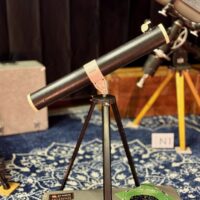
Gilbert 63mm Reflector
A popular entry-level telescope from the mid-20th century, the Gilbert 63mm reflector introduced many amateur astronomers to the wonders of the night sky. With its achromatic lens and simple altazimuth or equatorial mounts, it provided crisp views of the Moon, planets, and bright star clusters. Affordable and accessible, the Gilbert telescopes remain a nostalgic symbol of backyard astronomy for generations.
The A.C. Gilbert Company, founded in 1909 by Alfred Carlton Gilbert, was one of the most innovative and influential toy companies of the 20th century. Headquartered in New Haven, Connecticut, the company initially specialized in manufacturing magic kits. However, it gained national fame with the release of the Erector Set in 1913, a construction toy that became an icon of American childhood.
Alfred Gilbert, a former Olympian and Yale graduate, believed in the power of toys to educate and inspire creativity. His Erector Set, featuring steel girders, nuts, bolts, and motors, was revolutionary because it allowed children to build working models of structures and machines. This hands-on approach to learning and play laid the groundwork for STEM-focused toys that followed.
Throughout the 1920s and 1930s, the A.C. Gilbert Company expanded its offerings to include chemistry sets, microscopes, and other scientific kits. These toys encouraged scientific exploration and positioned the company as a pioneer in educational toys. Gilbert’s products often targeted boys, reflecting the gender norms of the time, and the company branded itself as a producer of tools to build future engineers and scientists.
The 1950s and 1960s saw increased competition from other toy manufacturers, as well as a decline in the popularity of Gilbert’s traditional toys. Efforts to diversify into slot cars and plastic models did not replicate the success of earlier products. After Alfred Gilbert’s death in 1961, the company struggled financially and was eventually sold in 1967. By 1969, the A.C. Gilbert Company had ceased operations.
Though the company no longer exists, its influence endures. The Erector Set remains a beloved classic, and Gilbert’s commitment to blending education and play is evident in many modern toys.
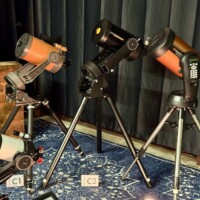
Celestron
8”
The Celestron 8″ models on display here are in the back the classic orange tube C8 built in the 70s, in the middle the black C8 that first appeared in 1984, and in the front, the most recent Nexstar 8 series announced in 2000.
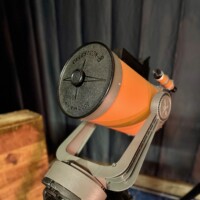
Celestron 8”
Celestron is a telescope manufacturing company whose name remains synonymous among the astronomical community with compact and versatile Schmidt-Cassegrain telescopes (SCTs). A Celestron Schmidt-Cassegrain telescope (SCT) was often the first astronomical instrument that a budding astronomer experienced at their High School or college, and these are still commonly found in use at government and industrial research applications as well as in a neighbor’s backyard. Celestron’s U.S.A.-made and imported products earned the well-deserved reputation of providing affordable value. The good reputation of Celestron was gained through their more than forty years of experience and success in innovative product design, most notably of their Schmidt-Cassegrain telescopes, by new innovations and continual product improvement, and their customer service. One can not underestimate the impact those pioneers at Celestron made in changing the marketplace for amateur astronomy. Celestron instruments made it possible for many amateurs to become enthralled by the hobby, and many of the now-famous names in astrophotography (and many others unpublished) were able to capture amazing images and earn recognition for their accomplishments and discoveries.

Celestron 8”
Celestron is a telescope manufacturing company whose name remains synonymous among the astronomical community with compact and versatile Schmidt-Cassegrain telescopes (SCTs). A Celestron Schmidt-Cassegrain telescope (SCT) was often the first astronomical instrument that a budding astronomer experienced at their High School or college, and these are still commonly found in use at government and industrial research applications as well as in a neighbor’s backyard. Celestron’s U.S.A.-made and imported products earned the well-deserved reputation of providing affordable value. The good reputation of Celestron was gained through their more than forty years of experience and success in innovative product design, most notably of their Schmidt-Cassegrain telescopes, by new innovations and continual product improvement, and their customer service. One can not underestimate the impact those pioneers at Celestron made in changing the marketplace for amateur astronomy. Celestron instruments made it possible for many amateurs to become enthralled by the hobby, and many of the now-famous names in astrophotography (and many others unpublished) were able to capture amazing images and earn recognition for their accomplishments and discoveries.

Celestron C5+
The Celestron 5” SCT was introduced by Celestron in 1971, just about a year after Celestron started their 8-inch SCT line with the C8. It was an orange tube, twin-arm SCT, and looked just like a scaled-down portable model of its larger sibling. The picture below shows a C5 from 1979.
In 1992, Celestron revived the 5-inch SCT and introduced the C5+. The C5+ came on a single-arm “fork” mount and was powered by a 9-volt battery. The scope was sold until 1999, when Celestron introduced the G5 and the Nexstar5.
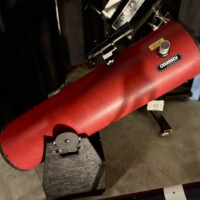
Coulter Odyssey Compact
Coulter Odyssey Compact 10.1″ Dobsonian. 254mm f/4.5 Newtonian Reflector, Coulter Optical, USA, ca. 1980s. A hallmark of the Dobsonian revolution, this 10.1-inch Newtonian reflector made deep-sky observing accessible to the masses. Manufactured by Coulter Optical in California, the Odyssey Compact combined a large aperture with an ultra-simple altazimuth mount. Its bright, wide-field views made it a favorite for observing nebulae, galaxies, and star clusters. Affordable and easy to use, it helped ignite a surge in amateur astronomy during the 1980s.
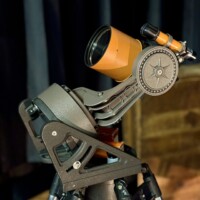
Celestron C90 Astro with Wedge and Tripod
The Celestron C90 is a 90mm f/11 Maksutov-Cassegrain. Introduced by Celestron International, USA, in 1977, is one of the most compact and portable telescopes. As a Maksutov-Cassegrain telescope, the C90 offered a departure from the traditional Newtonian and Schmidt-Cassegrain designs prevalent at the time. Celestron, founded in 1960 by Tom Johnson, was already a leader in the telescope market with its revolutionary Schmidt-Cassegrain designs. By the mid-1970s, the company recognized a growing demand for smaller, more affordable, and multifunctional telescopes. The result was the C90—a compact Maksutov-Cassegrain telescope that balanced good optics with an accessible price point. The design quickly gained popularity not only among amateur astronomers but also among photographers, birdwatchers, and even military users due to its rugged construction and fine optics. The C90 employs the Maksutov-Cassegrain optical system, which features a full-aperture meniscus corrector lens paired with spherical primary and secondary mirrors. This design minimizes optical aberrations, such as coma and spherical aberration. The C90 has a 90mm aperture and a 1000 mm focal length. Over the years, the C90 underwent several updates, including improvements in optical coatings and mechanical designs. The most recent models feature enhanced multi-coatings for improved light transmission and sharper images. Despite these updates, the fundamental design of the C90 has remained true to its original concept, a testament to the brilliance of its initial engineering.
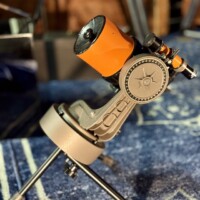
Celestron C90 Astro Tabletop
The Celestron C90 is a 90mm f/11 Maksutov-Cassegrain. Introduced by Celestron International, USA, in 1977, is one of the most compact and portable telescopes. As a Maksutov-Cassegrain telescope, the C90 offered a departure from the traditional Newtonian and Schmidt-Cassegrain designs prevalent at the time. Celestron, founded in 1960 by Tom Johnson, was already a leader in the telescope market with its revolutionary Schmidt-Cassegrain designs. By the mid-1970s, the company recognized a growing demand for smaller, more affordable, and multifunctional telescopes. The result was the C90—a compact Maksutov-Cassegrain telescope that balanced good optics with an accessible price point. The design quickly gained popularity not only among amateur astronomers but also among photographers, birdwatchers, and even military users due to its rugged construction and fine optics. The C90 employs the Maksutov-Cassegrain optical system, which features a full-aperture meniscus corrector lens paired with spherical primary and secondary mirrors. This design minimizes optical aberrations, such as coma and spherical aberration. The C90 has a 90mm aperture and a 1000 mm focal length. Over the years, the C90 underwent several updates, including improvements in optical coatings and mechanical designs. The most recent models feature enhanced multi-coatings for improved light transmission and sharper images. Despite these updates, the fundamental design of the C90 has remained true to its original concept, a testament to the brilliance of its initial engineering.
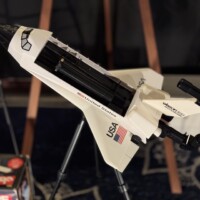
Jason SS1 Shuttle Scope
This 50mm refractor, marketed as the “Shuttle Scope,” was designed as a space-themed educational telescope during the excitement of the Space Shuttle era. With a 600mm focal length and simple altazimuth mount, it offered beginner-friendly views of the Moon and planets. Made in Japan and distributed by Jason/Empire Inc. in the 1980s, it featured playful styling—often with NASA-inspired graphics—and was aimed at sparking interest in space among children during the height of America’s shuttle program. Though modest in optics, it holds nostalgic value for a generation of young stargazers.

Bushnell Sky Chief II
The Sky Chief II is a long-focus 60mm achromatic refractor with a focal length of 910mm (f/15.2), offering crisp, high-magnification views ideal for the Moon, planets, and double stars. Manufactured in Japan during the 1970s for Bushnell, this telescope was part of a wave of well-made, affordable instruments that introduced a generation to amateur astronomy. Its slender tube and classic altazimuth or equatorial mounts were common features of the era, reflecting a balance of quality optics and accessible design for beginners.

Jason Powerzoom Telescope
This unusual handheld telescope combines a 30mm objective lens with variable 8–25× magnification in a pistol-grip design. Manufactured in Japan for Jason/Empire Inc. in the 1980s, it was marketed for casual terrestrial viewing—birdwatching, sporting events, or scenic observation. Its zoom capability and compact form factor made it a novelty item in the 1980s, blending optical function with ergonomic flair. While not intended for astronomy, it reflects the era’s experimentation with form and function in consumer optics.
Eyepiece Collection

Tele Vue
Tele Vue’s first generation Nagler (right) and Widefield (left) eyepieces. In 2005, Astronomy ran an article titled The Eyepiece that Changed Observing. In it Michael E. Bakich stated:
“On July 3, 1979, Al Nagler completed and dated the original technical drawing for the first of a series of eyepieces to carry his name. In November of that year, he applied for a patent, which was subsequently granted. The 13mm Nagler eyepiece went into production in 1980. Two additional first-generation Nagler eyepieces followed: the 9mm and the 4.8mm. These eyepieces made quite a stir when they were introduced. As well as being the highest-priced eyepiece for amateurs, the 13mm Nagler eyepiece was the first with a dual barrel, both 1-1⁄4″ and 2″, with an 82° apparent field of view to combine an expanded field of view and sharp images in the center and at the edge, and with eye relief longer than its focal length.”
Tele Vue produced this eyepiece until 2001, when it was replaced by the 13mm Type 6 Nagler with the same 82˚ field of view, weighing one-quarter as much and boasting higher-quality optical elements.
In all, the original Nagler eyepiece series, also called type 1, included focal lengths of 4.8mm, 7mm, 9mm, 11mm, and the 13mm that started it all.
In 1982, Al Nagler finalized the design for their Wide Field series. This new six-element eyepiece design provides a 65-degree apparent field of view. They were introduced in 1983 and patented in 1985. Initially offered in focal lengths of 19 and 24 mm with 1.25-inch barrels and 32 and 40 mm with 2-inch diameter barrels. In 1984, TeleVue added a 15mm Wide Field eyepiece. Astronomy Magazine reviewed these eyepieces and called them the sharpest eyepieces they had ever viewed through. The Wide Field design appealed to observers due to their improved correction over more traditional wide-angle designs of that time.
The 40mm Wide Field was about the most massive eyepiece available to the amateur, and it provided a breathtaking view that area approached the TeleVue 55mm Plossl by showing 90 percent (by diameter) of the 55mm Plossl field of view at a higher magnification.
An early accolade for the 40mm was that Michael Rudenko discovered Comet Levy-Rudenko in 1984 using his 40mm Wide Field while David Levy chose the 13mm Nagler for critical studies of the comet he co-discovered.

Carl Zeiss Jena
Carl Zeiss, Otto Schott, and Ernst Abbe developed numerous optical instruments and were co-owners of Carl Zeiss AG, the German manufacturer best known for scientific microscopes, astronomical telescopes, planetariums, and other advanced optical systems.
Abbe received his PhD from the University of Göttingen on 23 March 1861. In 1866, he became a research director at the Zeiss Optical Works, and in 1868, he invented the apochromatic lens, a microscope lens that eliminates both primary and secondary color aberrations.
The Carl Zeiss Jena orthoscopic eyepieces were made
Carl Zeiss near his workshop in Jena. in focal lengths of 4, 6, 8, 10, 12.5, 16, 25, and 40 mm and had barrels of 0.965 inch diameter. They were produced from before 1930 to the early 90s with some changes to the overall design and coatings.
This now famous orthoscopic design originated from Zeiss. Ernst Abbe was a physicist who worked for Carl Zeiss during the late 19th and early 20th centuries and is credited with creating this design in 1880. It consists of a triplet cemented field lens and a singlet eye lens for four elements of glass.

Edmund Scientific RKE
The Edmund Scientific RKE (Rank-Kaspereit-Erfle) eyepieces are well-regarded in the amateur astronomy community for their simplicity, optical quality, and affordability. Introduced in 1979 by Edmund Scientific, these eyepieces were designed by Dr. David Rank, a physicist and optical designer, as a refinement of the earlier Kellner and Erfle designs and without the complexity and cost of more elaborate designs like Plössls or orthoscopics. Over time, the line became popular among amateur astronomers for its high contrast, sharp images, and relatively low cost.
Despite the emergence of more advanced eyepiece designs, RKE eyepieces remain in production today, making them the longest-running eyepiece series.
RKE eyepieces have three optical elements and offer an apparent field of view of about 45–50 degrees, which is narrower than most modern eyepieces. The design offers comfortable eye relief, especially in the longer focal lengths, making them suitable for users who wear glasses. The lenses are fully multi-coated to reduce glare and maximize light transmission. The line includes focal lengths of 8, 12, 15, 21, and 28 mm. Of those, all, except the 15 mm RKE, can still be purchased new from Edmund Scientific.
The 28mm RKE, in particular, is celebrated for its immersive viewing experience, often described as a “floating image” effect due to its optical properties. Known for their sharp central resolution, high contrast, and low chromatic aberration, the eyepieces are well regarded for planetary observation and lunar viewing.
Meteorite Collection
About the Museum
Our Chiefland Astronomy Heritage Museum is located at the Chiefland Astronomy Village. It was founded on October 24, 2024 and officially dedicated on March 29, 2025.
The museum is managed and operate by our dedicated volunteers:
- Director and Curator: Dr. Richard G. Hennig
- Restoration: David Froiseth
- Facilities: Lisa Eager
- Communications: Matthew Peters
- Archivist: Sarah Coates
- Community Outreach: Larry Arbeiter












